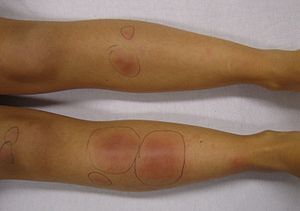
Erythema nodosum

Erythema nodosum (EN), is an inflammatory condition characterized by inflammation of the fat cells under the skin, resulting in tender red nodules or lumps that are usually seen on both shins. It can be caused by a variety of conditions, and typically resolves spontaneously within 30 days. It is common in young people between 12–20 years of age. Erythema nodosum (EN), is an inflammatory condition characterized by inflammation of the fat cells under the skin, resulting in tender red nodules or lumps that are usually seen on both shins. It can be caused by a variety of conditions, and typically resolves spontaneously within 30 days. It is common in young people between 12–20 years of age. The first signs of erythema nodosum are often flu-like symptoms such as a fever, cough, malaise, and aching joints. Some people also experience stiffness or swelling in the joints and weight loss. Erythema nodosum is characterised by 1–2-inch (25–51 mm) nodules (rounded lumps) below the skin surface, usually on the shins. These subcutaneous nodules can appear anywhere on the body, but the most common sites are the shins, arms, thighs, and torso. Each nodule typically disappears after around two weeks, though new ones may continue to form for up to six or eight weeks. A new nodule usually appears red and is hot and firm to the touch. The redness starts to fade and it gradually becomes softer and smaller until it disappears. Each nodule usually heals completely without scarring over the course of about two weeks. Joint pain and inflammation sometimes continue for several weeks or months after the nodules appear.
